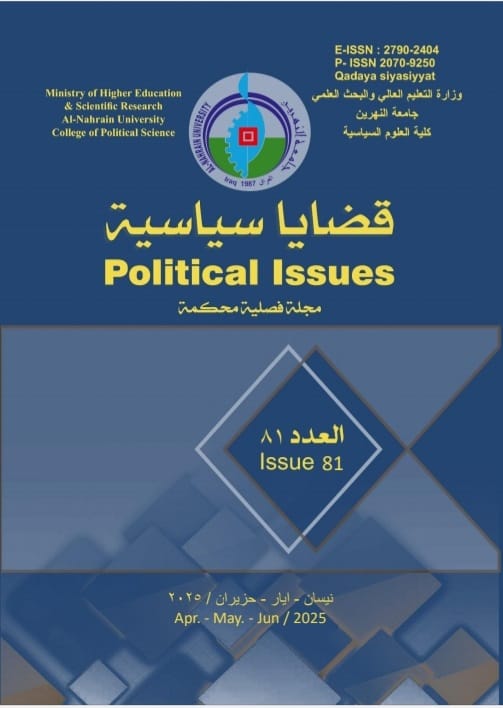مضيق ملقا بين الأهمية الجيواقتصادية وتحديات الأمن الإقليمي والدولي
DOI:
https://doi.org/10.58298/812025746الكلمات المفتاحية:
مضيق ملقا ، الارهاب البحري، القرصنة البحرية، أمن الطاقةالملخص
يُعد مضيق ملقا أحد أهم الممرات البحرية الاستراتيجية في العالم، إذ يربط ما بين المحيطين الهادئ والهندي، ويُعد الشريان الأساس لحركة التجارة والطاقة بين الشرق والغرب، وتظهر أهمية المضيق من الناحية الجيواقتصادية كونه يمثل ممراً لنحو ربع حجم التجارة العالمية، وأكثر من (90000) سفينة سنوياً، و(30%) من تدفقات النفط العالمية، مما يجعله عاملاً حاسماً في الاقتصاد العالمي.
غير ان هذه الأهمية تصاحبها تحديات أمنية متزايدة تشمل القرصنة والإرهاب البحري والصيد غير المشروع والتهديدات البيئية، فضلاً عن التنافس الجيوسياسي ما بين القوى الكبرى والدول المتاخمة للمضيق، ويخلص البحث الى ان الحفاظ على أمن المضيق يتطلب تعاوناً اقليمياً ودولياً متزايداً، ومواجهة التحديات المتعددة لضمان استدامة الملاحة في هذا الممر الحيوي.
المراجع
- موسى، مروة عدي، ومطلك، دنيا جواد. (2024). "الأهمية الاستراتيجية لمضيق ملقا وأثره في التنافس الأمريكي- الصيني". مجلة حمورابي للدراسات، المجلد (13). العدد (49). ص161-162.
- Rodrigue, Jean-Paul. (2004). "Straits, Passages and Chokepoints A Maritime Geostrategy of Petroleum Distribution". Geography notebooks of Quebec, 48(135). p.369.
- Jariod, Elisenda Ventura. (2019). "Prospection and Analysis of New Maritime Trade Nets of Asia in the Malacca Strait". Degree in Nautical and Maritime Transport. Nautical Faculty of Barcelona Polytechnic University of Catalonia. p.14.
- Elisenda, Ventura Jariod & de Osés, F.X. Martínez. (2020). "The role of the Malacca Strait in the one belt, one road initiative". Maritime Transport Conference, No. 8 .The Polytechnic University of Catalonia.
- Noraini, Zulkifli & Ibrahim,Raja & Fahmi, Ismail & Azrul, Azlan & Amer,Yasid. (2020). "Maritime Cooperation in the Straits of Malacca (2016-2020): Challenges and Recommend For a New Framework". 2, p.11-12.
- Dent,Thomas. (2023). "The Strait of Malacca’s Global Supply Chain Implications". https://www.ismworld.org/supply-management-news-and-reports/news-publications/inside-supply-management-magazine/blog/2023/2023-11/the-strait-of-malaccas-global-supply-chain-implications/?utm_source=chatgpt.com
- Rusli, Mohd & Hazmi Bin, Mohd & Ade, Suherman & Aryuni, Yuliantiningsih & Wismaningsih, Wismaningsih & Noer, Indriati. (2021). "The Straits of Malacca and Singapore: Maritime Conduits of Global Importance". Research in World Economy. 12. 123.
- Hans-Dieter, Evers & Solvay, Gerke. (2006). "The Strategic Importance of the Straits of Malacca". SSRN Electronic Journal, p.8.
- Ismail, Siti Zubaidah & Sani, Mohd Azizuddin Mohd. (2010). "The Straits of Malacca: Regional Powers Vis-A-Vis Littoral States in Strategic and Security Issues and Interests". In: Proceedings Seminar on Nasional Resilience (SNAR 2010) "Political Managements and Policies in Malaysia", 13-15 July 2010, Bayview Hotel Langkawi. Institute of Tun Dr. Mahathir Mohamad’s Thoughts,Universiti Utara Malaysia , Sintok, p.86.
- Mohammed, Israa Saadi & Mohammed, Dr. Ahmed Ali. (2023). "Strategic Importance and Maritime Terrorism in the Strait of Malacca". Migration Letters 20 (S6). London, UK:p.489.
- Muhamad, Faisal. (2024). "Maritime Security and Safety in the Strait of Malacca: An Analysis of Threats and Mitigation Strategies". https://ssrn.com/abstract=5074160
- Awal, Syahrul & Sumadinata, R. Widya Setiabudi & Yani, Yanyan Mochamad & Sudirman, Arfin . (2025). "Defense Stability and Ecosystem Sustainability in the Strait of Malacca: Maritime Security Challenges from an International Relations Perspective". E3S Web Conf, vol (611), p.5007-5009.
- Bibi, Hajra & H., Aimen, U. e, & Farooq, H. (2024). "Strait of Malacca and the Maritime Security: Safeties of the Regional Powers". Annals of Human and Social Sciences, 5(4), p.496.
- Myers, Lucas. (2023). "China’s Economic Security Challenge: Difficulties Overcoming the Malacca Dilemma".
- abderrazak, mokhtari. (2025). "Sino-American rivalry over the strategic Strait of Malacca". Afak for Sciences journal (ASJP), Volume: 10/ No: 01, p.119-120.
- Pitakdumrongkit, Kaewkamol. (2023). "Interview from the Center for Innovation, Trade, and Strategy, The Strait of Malacca’s Impact on Regional Trade". https://www.nbr.org/publication/geoeconomic-crossroads-the-strait-of-malaccas-impact-on-regional-trade/
- Total Number of Ships Passing Through the Strait of Malacca from 2000 to 2022. https://mehsoms.net/maritime-safety/straitrep-statistics/ships-passing-through/?utm_source=chatgpt.com
- Klang, Port. (2025). "New annual record for the transit of ships in the Straits of Malacca and Singapore" https://www.informare.it/news/gennews/2025/20250028-Stretti-Malacca-Singapore-transiti-Y-2024uk.asp?utm_source=chatgpt.com
- U.S. Energy Information Administration (EIA). (2024). https://www.eia.gov/international/analysis/specialtopics/World_Oil_Transit_Chokepoints
- U.S. Energy Information Administration (EIA), (2024). "Short-Term Energy Outlook, May 2024, and EIA analysis based on Vortexa tanker tracking and Panama Canal Authority, using EIA conversion factors and calculations"https://www.eia.gov/international/content/analysis/special_topics/World_Oil_Transit_Chokepoints/
- U.S. Energy Information Administration (EIA). (2024). https://www.eia.gov/international/analysis/special-topics/World_Oil_Transit_Chokepoints
- ReCAAP.org (2023). "Number of Incidents 2014-2023. Severity of Incidents”.
https://www.recaap.org/resources/ck/files/reports/annual/ReCAAP%20ISC%20Annual%20Report%202023.pdf
الملفات الإضافية
منشور
إصدار
القسم
الرخصة
الحقوق الفكرية (c) 2025 محمد حميد محمد

هذا العمل مرخص بموجب Creative Commons Attribution 4.0 International License.
هذه هي مقالـــــة منشـــــــــورة بنمط الوصـــــول الحـــــــر ومـــــــوزعة تحــــــت شــــــروط ترخيص المشاع الابداعي نسب المصنف (CC BY) 4.0 دولي التي تسمح بالاستخدام غير المقيد، التوزيع، واعادة الانتاج في أي وسيط أو صيغة، والتحوير أو البناء على المادة، بما في ذلك للأغراض التجارية، شريطة أن يتم نسب العمل للمؤلف الأصلي.






